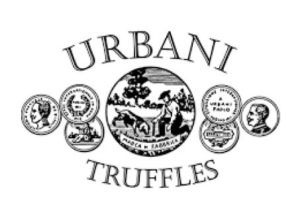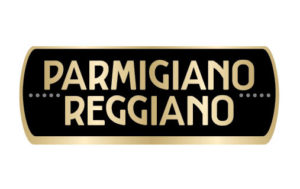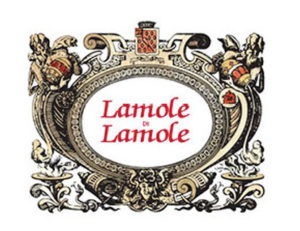
Directions:
STEP 1
To make the dough: Sift together and then mound 3 cups of the flour in the center of a large wooden cutting board. Make a well in the middle of the flour and add the eggs. Using a fork, beat together the eggs and begin to incorporate the flour, starting with the inner rim of the well.
As you expand the well, keep pushing the flour up from the base of the mound to retain the well shape. The dough will come together when half of the flour is incorporated.
STEP 2
Start kneading the dough with both hands, using the palms of your hands. Knead for about 15 minutes, adding any of the remaining four if necessary to create a cohesive mass. Once you have a cohesive mass, remove the dough from the board and scrape up and discard any leftover bits. Lightly reflour the board and continue kneading for 6 more minutes. The dough should be elastic. Cover the dough in plastic or a moist towel and allow to rest for 30 minutes at room temperature.
STEP 3
In a 12-inch saucepan, add 1 tablespoon butter over high heat until hot but not smoking. Add the garlic, and cook, about 5 minutes. Add the veal, and cook for about 7 to 8 minutes. Season with salt and pepper, to taste.
STEP 4
In a fitting pot, melt butter and add Savoy cabbage and ¼ cup of water. Cover with a lid and cook until cabbage is very tender. Chop in food processor until almost smooth.
STEP 5
Let the veal cool until room temperature, the place in a large mixing bowl. Stir in the Parmigiano, cabbage, veal broth, a pinch of nutmeg, and salt and pepper, to taste. Use a wooden spoon to mix until well combined. Set aside.
STEP 6
Cut the pasta dough into 3 equally sized pieces. Re-wrap 2 of the pieces in plastic wrap and set aside. Begin working with the 1 unwrapped piece of dough. On a lightly floured work surface, use a floured rolling pin to roll out the pasta dough until it is 1/8-inch thick (you can also use a pasta machine and roll out the dough on its thinnest setting).
STEP 7
Lay the resulting pasta sheet on a lightly floured surface with a long side facing you. Trim the edges so they are straight. Using pastry bag or ziplock bag with a corner cut out, pipe out equal amounts of the filling (about 1 tea spoon) and place along the bottom half of the pasta sheet, leaving a 1 1/2-inch border of dough at the bottom and sides: each dollop of filling should be approximately 1 1/2-inches away from the next. Pull the top edge of the pasta up and over the filling. The dough should form 1 large pocket over the dollops of filling. Seal the agnolotti by gently carefully molding the pasta over the filling and pressing lightly with your index finger to seal the edge of the dough to the pasta sheet;. When it is sealed, there should be about 1/2-inch of excess dough visible along the bottom of the mounds of filling. Make sure that you are sealing tightly while removing any pockets of air. Seal the left and right ends of the dough.
STEP 8
To shape agnolotti: Starting at 1 end of the dough, place the thumb and forefinger of each hand together as if you were going to pinch something and, leaving about 1-inch of space between your hands and holding your fingers vertically, pinch the filling in 1-inch increments, making about 3/4-inch of “pinched” are between each pocket of filling. It is important to leave this much “pinched” area between the agnolotti, or when the agnolotti are separated, they may come unsealed. Run a sharp knife or crimped pastry wheel along the bottom edge of the folded-over dough, separating the strip of filled pockets from the remainder of the pasta sheet. Don’t cut too close to the filling, or you risk breaking the seal. Separate the individual agnolotti by cutting the center of each pinched area, rolling the pastry wheel away from you. Working quickly, place the agnolotti on a baking sheet dusted with a thin layer of cornmeal, which will help prevent sticking. Don’t let the agnolotti touch each other, or they may stick together.
STEP 9
Repeat with the 2 remaining dough balls until the entire bowl of filling is used up.
Bring 8 quarts water to a rolling boil, and add 2 tablespoons salt. Add the agnolotti to the water and cook until tender, about 4 minutes total. Drain well and toss with melted truffle butter and some meat broth. Grate or shave fresh truffles over the pasta and sprinkle with Parmigiano Reggiano .
MAIN
Veal Agnolotti with Summer Truffles & Parmigiano Reggiano®
-
15m
PREP
-
10m
COOK
-
370
CALORIES
-
4
SERVINGS
Recipe by:
Perbacco Restaurant
230 California St.
San Francisco, CA 94111
Description:
Agnolotti is a type of pasta typical of the Piedmont region of Italy. It is similar to ravioli, except that ravioli is prepared from two pieces of pasta cut into squares, while agnolotti is made from a single piece that is folded over. Agnolotti are usually stuffed with cheese, meat, fish, or a combination of those ingredients. For this recipe, the chef of Perbacco has provided instructions for handmade agnolotti with a veal filling which pairs well with have the elegant, earthy, and slightly floral flavor of Urbani Summer Truffles and the distinctive taste of Parmigiano Reggiano cheese. The combination will surprise and delight your palate.
Ingredients:
For the dough:
– 3 cups Italian “00” flour or all-purpose flour
– 5 whole large eggs,
– 5 egg yolks
For the filling:
– 2 tablespoon butter
– 1 garlic clove, sliced
– 2 pounds roasted veal shoulder or breast, chopped in food processor
– 2 oz grated Urbani Summer Truffles
– 2 cups Savoy cabbage, cut into 1” pieces
– ½ cup reduced veal or beef broth
– 1 1/2 cup freshly grated Parmigiano Reggiano cheese
– Freshly grated nutmeg, to taste
– Salt and freshly ground black pepper, to taste
– 4 tbsp Urbani Truffle Butter
How to cook with Black Truffles
Black truffles work well with ingredients like butter and cheese because the fat in these ingredients absorbs the earthy truffle flavor and carries it through the whole dish.

How to spot Parmigiano Reggiano cheese
To make sure that you are buying Parmigiano Reggiano cheese, look for the distinctive dotted rind and make sure it is a product of Italy, otherwise it is not Parmigiano Reggiano.

Wine Pairing

Chianti Classico Riserva
by Lamole di Lamole.

MAIN
Veal Agnolotti with Summer Truffles & Parmigiano Reggiano®
-
15m
PREP
-
10m
COOK
-
370
CALORIES
-
4
SERVINGS
Recipe by:
Perbacco Restaurant
230 California St.
San Francisco, CA 94111
Directions:
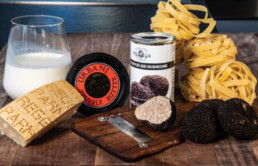
STEP 1
To make the dough: Sift together and then mound 3 cups of the flour in the center of a large wooden cutting board. Make a well in the middle of the flour and add the eggs. Using a fork, beat together the eggs and begin to incorporate the flour, starting with the inner rim of the well.
As you expand the well, keep pushing the flour up from the base of the mound to retain the well shape. The dough will come together when half of the flour is incorporated.
STEP 2
Start kneading the dough with both hands, using the palms of your hands. Knead for about 15 minutes, adding any of the remaining four if necessary to create a cohesive mass. Once you have a cohesive mass, remove the dough from the board and scrape up and discard any leftover bits. Lightly reflour the board and continue kneading for 6 more minutes. The dough should be elastic. Cover the dough in plastic or a moist towel and allow to rest for 30 minutes at room temperature.
STEP 3
In a 12-inch saucepan, add 1 tablespoon butter over high heat until hot but not smoking. Add the garlic, and cook, about 5 minutes. Add the veal, and cook for about 7 to 8 minutes. Season with salt and pepper, to taste.
STEP 4
In a fitting pot, melt butter and add Savoy cabbage and ¼ cup of water. Cover with a lid and cook until cabbage is very tender. Chop in food processor until almost smooth.
STEP 5
Let the veal cool until room temperature, the place in a large mixing bowl. Stir in the Parmigiano, cabbage, veal broth, a pinch of nutmeg, and salt and pepper, to taste. Use a wooden spoon to mix until well combined. Set aside.
STEP 6
Cut the pasta dough into 3 equally sized pieces. Re-wrap 2 of the pieces in plastic wrap and set aside. Begin working with the 1 unwrapped piece of dough. On a lightly floured work surface, use a floured rolling pin to roll out the pasta dough until it is 1/8-inch thick (you can also use a pasta machine and roll out the dough on its thinnest setting).
STEP 7
Lay the resulting pasta sheet on a lightly floured surface with a long side facing you. Trim the edges so they are straight. Using pastry bag or ziplock bag with a corner cut out, pipe out equal amounts of the filling (about 1 tea spoon) and place along the bottom half of the pasta sheet, leaving a 1 1/2-inch border of dough at the bottom and sides: each dollop of filling should be approximately 1 1/2-inches away from the next. Pull the top edge of the pasta up and over the filling. The dough should form 1 large pocket over the dollops of filling. Seal the agnolotti by gently carefully molding the pasta over the filling and pressing lightly with your index finger to seal the edge of the dough to the pasta sheet;. When it is sealed, there should be about 1/2-inch of excess dough visible along the bottom of the mounds of filling. Make sure that you are sealing tightly while removing any pockets of air. Seal the left and right ends of the dough.
STEP 8
To shape agnolotti: Starting at 1 end of the dough, place the thumb and forefinger of each hand together as if you were going to pinch something and, leaving about 1-inch of space between your hands and holding your fingers vertically, pinch the filling in 1-inch increments, making about 3/4-inch of “pinched” are between each pocket of filling. It is important to leave this much “pinched” area between the agnolotti, or when the agnolotti are separated, they may come unsealed. Run a sharp knife or crimped pastry wheel along the bottom edge of the folded-over dough, separating the strip of filled pockets from the remainder of the pasta sheet. Don’t cut too close to the filling, or you risk breaking the seal. Separate the individual agnolotti by cutting the center of each pinched area, rolling the pastry wheel away from you. Working quickly, place the agnolotti on a baking sheet dusted with a thin layer of cornmeal, which will help prevent sticking. Don’t let the agnolotti touch each other, or they may stick together.
STEP 9
Repeat with the 2 remaining dough balls until the entire bowl of filling is used up.
Bring 8 quarts water to a rolling boil, and add 2 tablespoons salt. Add the agnolotti to the water and cook until tender, about 4 minutes total. Drain well and toss with melted truffle butter and some meat broth. Grate or shave fresh truffles over the pasta and sprinkle with Parmigiano Reggiano .
Description:
Agnolotti is a type of pasta typical of the Piedmont region of Italy. It is similar to ravioli, except that ravioli is prepared from two pieces of pasta cut into squares, while agnolotti is made from a single piece that is folded over. Agnolotti are usually stuffed with cheese, meat, fish, or a combination of those ingredients. For this recipe, the chef of Perbacco has provided instructions for handmade agnolotti with a veal filling which pairs well with have the elegant, earthy, and slightly floral flavor of Urbani Summer Truffles and the distinctive taste of Parmigiano Reggiano cheese. The combination will surprise and delight your palate.
Ingredients:
For the dough:
– 3 cups Italian “00” flour or all-purpose flour
– 5 whole large eggs,
– 5 egg yolks
For the filling:
– 2 tablespoon butter
– 1 garlic clove, sliced
– 2 pounds roasted veal shoulder or breast, chopped in food processor
– 2 oz grated Urbani Summer Truffles
– 2 cups Savoy cabbage, cut into 1” pieces
– ½ cup reduced veal or beef broth
– 1 1/2 cup freshly grated Parmigiano Reggiano cheese
– Freshly grated nutmeg, to taste
– Salt and freshly ground black pepper, to taste
– 4 tbsp Urbani Truffle Butter
How to cook with Black Truffles
Black truffles work so well with rich ingredients like butter and cheese, the fat in these ingredients absorbs the truffle flavor and carries it through the whole dish

How to spot Parmigiano Reggiano cheese
To make sure that you are buying Parmigiano Reggiano cheese, look for the distinctive dotted rind and make sure it is a product of Italy, otherwise it is not Parmigiano Reggiano.

Wine Pairing
 Amarone della Valpolicella Classico DOCG “Costasera”
Amarone della Valpolicella Classico DOCG “Costasera”

FEATURED VIDEO RECIPE
Urbani Black Truffle &Parmigiano Reggiano
Chef Michele Casadei Massari shows you how to make a special dish using Urbani Balck Truffles and Parmigiano Reggiano, and pairs it with an exceptional wine from Ca’ del Bosco.
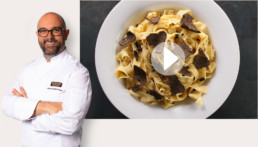
Participating Restaurants
This list of participating restaurants will be updated frequently until the week of the event.
Reservations can be made directly through each restaurant or through Open Table.
